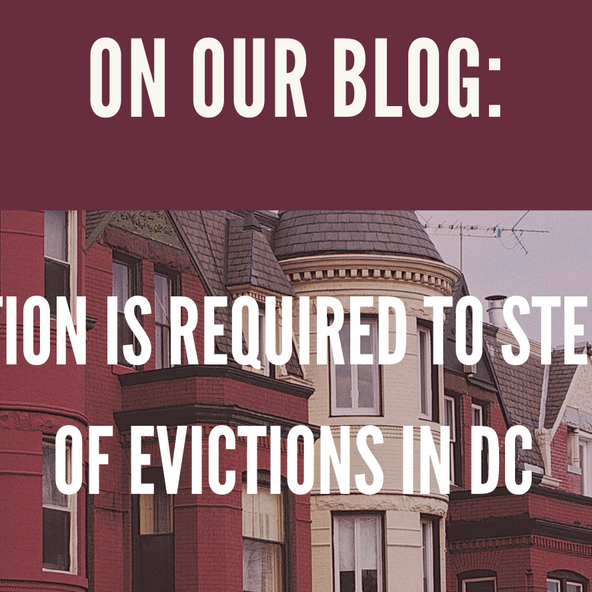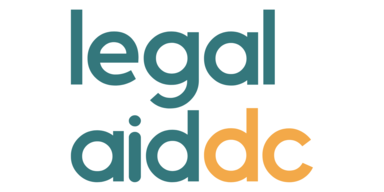
In the last month, researchers at nine national organizations and institutes have released analyses estimating the devastating wave of evictions facing tenants across the U.S. The National Coalition for a Civil Right to Counsel and the consulting firm Stout Risius Ross, LLC released a new tool that allows users to easily view relevant Census Bureau data related to eviction by state. According to Stout’s tool, currently 36.6% of Washington, DC’s renting population will be at risk of eviction when the eviction moratorium expires in December, which is equivalent to around 57,000 households. They report that the District’s estimated rent shortfall is currently a staggering $79 million. And these numbers will only go up with time.
Particularly jarring is the disparity between white renters and renters of color that reflects the state of the District’s racial wealth gap prior to the pandemic. As of the end of July, only 38.8% of Black and 31.2% of Latinx renters reported having high confidence in their ability to pay August rent, compared with over 80% of white renters. Likewise, only 8.9% of white renters reported having very little or no confidence in their ability to pay August rent, while 43.1% of Black renters and 63.8% of Latinx renters reported very little or no confidence.
The disparity along income lines is similarly stark. As of the end of July, 58.1% of renters with annual incomes of under $50,000 reported having little or no confidence in their ability to pay August rent. For households with annual incomes at or above $50,000 however, just 12.6% shared this concern.
The District’s affordable housing crisis existed long before the onset of COVID-19, with some of the fastest rates of gentrification and displacement and highest per capita rate of homelessness in the country. It is impossible not to see the bleak picture that this tool paints for the future for low-income Black and brown tenants in the District of Columbia.
The DC Council, Mayor, and the DC Superior Court have responded to this emergency with a number of actions that have served to protect tenants from losing their homes in the midst of the pandemic, earning the District a rating of 4.0/5.0 from Princeton University's Eviction Lab. For instance, when the Mayor extended the Public Health Emergency to October 9th, the moratoriums on both evictions and the filing of eviction cases were both extended well into the fall. Actual evictions cannot begin until October 9th, and new eviction cases cannot be filed until December 8th. These protections have been vital to holding off the coming eviction crisis, but ultimately they will not stop it.
Two new programs have also been established by the Department of Housing and Community Development (DHCD), the Tenant-Based Rental Assistance Program (TBRA) and the COVID-19 Housing Assistance Program (CHAP), funded at $1.5 million and $6.2 million respectively. These are in addition to the already-existing Emergency Rental Assistance Program (ERAP) run by the Department of Human Services, which is now funded at $13.85 million after the Council’s $6 million budget increase last month.
These programs alone, however, simply cannot meet the vast need of tenants in the District. The high price of monthly rent, relatively low limit of how much assistance a household can receive, and other varying eligibility criteria create significant barriers to this assistance successfully mitigating the threat of eviction for many households. And the revelation that there appears to be no end in sight for the pandemic makes it difficult to imagine how effective these programs will be in stemming the massive tide of evictions to come once the moratorium lifts in December.
In June, Mayor Muriel Bowser asked the residents of the District of Columbia to complete a survey asking what we, as a District, as a community, are most concerned with in the process of reopening. Overwhelmingly, our city listed ‘vulnerable communities’ (82%) and ‘equity’ (70%) as our top priorities. Tenant groups from across the city have been fighting for rent cancellation, mobilizing tenants to come together in negotiating with their landlords, and pressuring the DC Council to do more to protect those most vulnerable to the threat of eviction.
With the expiration of CARES Act protections on July 24th, including the untimely expiration of pandemic unemployment benefits, and Congress on recess without the passage of another relief act, there is no clear federal aid in sight. So it will be up to our Council and Mayor to prioritize protecting DC’s renters. Next month, the Council has the opportunity to lengthen the current eviction moratorium and should take it (Virginia is currently considering a moratorium proposal that would last well into 2021). Policymakers should also seriously consider other proposals aimed at keeping people in their homes, including increasing funds for (and removing significant barriers to) financial assistance programs for tenants who have fallen behind on their rent, and rent cancellation. It is apparent that action that matches the unprecedented nature of the moment is required from the District’s leaders. And if it is not taken, Stout’s tool makes clear who will shoulder the burden of the $79 million rent shortfall, which is only on track to grow larger with time: low-income tenants of color.




